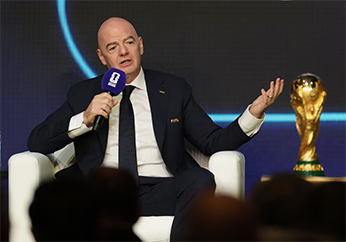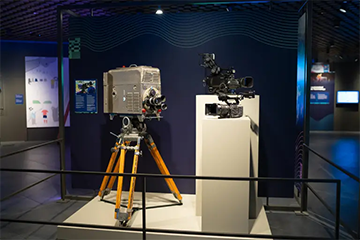Governing Bodies
ORIGINAL 125-YEAR OLD OLYMPIC GAMES DOCUMENTS SOLD FOR $8.8 MILLION AT AUCTION
BY DUNCAN MACKAY.
The manifesto which led to the revival of the Olympic Games more than 120 years ago has sold for a record $8,806,500 (£6,764,543/€7,916,191) at an auction in New York City.
The historic artifact was expected to sell for between $700,000 (£535,000/€630,000) and $1 million (£770,000/€900,000), but ended up in the hands of a bidder for over eight times the estimate.
According to Sotheby’s which hosted the auction, it is the highest price ever paid for an item of piece of sports memorabilia, breaking the previous record set by a Babe Ruth New York Yankees baseball jersey that sold for $5.4 million (£4.1 million/€4.8 million) earlier this year.
The previous record at auction for a piece of Olympic memorabilia was the $1,466,574 (£1,132,239/€1,324,488) that a buyer paid for one of Jesse Owens’ four gold medals from Berlin 1936.
The 14-page document dates back to 1892 and was written by Pierre de Coubertin, founder of the International Olympic Committee (IOC).
The price skyrocketed as those present at the auction in New York participated in a lengthy 12-minute bidding war.
Sotheby’s has not announced who the bidders were or who eventually won the battle for the documents.
The 5,000 words hand-written document highlights why Coubertin wanted to bring the Ancient Greek tradition of Olympic competition back during an address he gave at the Sorbonne University in Paris two years before the formation of the IOC in 1894.
He outlined how he believed the Games could be a way to provide peaceful competition between countries.
“It is clear that the telegraph, railways, the telephone, the passionate research in science, congresses and exhibitions have done more for peace than any treaty or diplomatic convention,” Coubertin wrote in the manifesto.
“Well, I hope that athletics will do even more.
“Those who have seen 30,000 people running through the rain to attend a football match will not think that I am exaggerating.
“Let us export rowers, runners and fencers; this is the free trade of the future, and the day that it is introduced into the everyday existence of old Europe, the cause of peace will receive new and powerful support,” he wrote in the document.
“That is enough to encourage me to think now about the second part of my programme.
“I hope that you will help me as you have helped me thus far and that, with you, I shall be able to continue and realize, on a basis appropriate to the conditions of modern life, this grandiose and beneficent work: the re-establishment of the Olympic Games.”
The unique piece of history went missing for quite some time between the two World Wars.
Frenchman Marquis d’Amat went searching for it in the 1990s and eventually located it from a collector in Switzerland.
The sale set a personal record for the auctioneer, too, who has never hammered numbers quite this high in his 30-plus years of book and manuscript sales.
“It was a personal honor to serve as today’s auctioneer, as this marks my highest price on the rostrum in more than three decades at Sotheby’s,” Selby Kiffer, senior specialist in Sotheby’s Books and Manuscripts Department, said.
-insidethegames
Governing Bodies
Pinnick at the Global Table: Nigeria’s Voice Heard at FIFA Deliberations in Doha

In the hushed corridors and high-ceilinged meeting rooms of Doha, where global football policy is debated long before it is felt on the pitch, Amaju Melvin Pinnick took his place among the game’s most influential decision-makers on Tuesday.
The former President of the Nigeria Football Federation (NFF) and current Deputy Chairperson of the FIFA Men’s National Team Competitions Committee featured prominently at the FIFA Plenary Session and Committee Meetings held in the Qatari capital — a gathering that brought together senior football administrators from across continents to shape the future of international football.


It was a moment of high-level deliberations, where discussions ranged from the structure and calendar of men’s national team competitions to broader strategic policies affecting FIFA tournaments worldwide.
At the centre of those conversations sat Pinnick, one of Africa’s most visible football administrators of the past decade, continuing Nigeria’s representation at the sport’s most powerful table.
The Doha meetings underlined the growing importance of collaborative governance in an increasingly congested global football calendar. With national teams, clubs and confederations navigating competing interests, FIFA’s Men’s National Team Competitions Committee plays a pivotal role in aligning policy with practicality — from qualification pathways to tournament formats and scheduling frameworks.
Pinnick’s presence at the session was not merely ceremonial. As a committee leader, he participated in deliberations that will influence how national teams prepare, qualify and compete in FIFA tournaments in the coming years. His involvement reflects a continuity of influence built during his tenure at the NFF, when Nigeria regained visibility and credibility within global football governance structures.
For Nigeria, the optics and substance of Pinnick’s role in Doha matter. In an era when representation often translates into influence, having a Nigerian administrator actively engaged in FIFA’s decision-making processes reinforces the country’s standing beyond results on the field. It also highlights Africa’s broader contribution to shaping global football policy, rather than merely responding to decisions taken elsewhere.
The Doha meetings also served as a reminder of FIFA’s increasingly global outlook, with Qatar — fresh from hosting the 2022 World Cup — continuing to position itself as a hub for international football diplomacy. Against that backdrop, Pinnick’s participation symbolised the intersection of experience, continuity and continental representation.
As the sessions concluded, the outcomes may not yet be visible to fans, but their impact will eventually be felt in future tournaments, qualification systems and competition structures. For now, Nigeria’s seat at the table — occupied by one of its most prominent football administrators — remains firmly secured.
In Doha, amid policy papers and strategic frameworks, Amaju Pinnick’s presence spoke quietly but clearly: Nigeria is still part of the conversation shaping world football’s next chapter.
Join the Sports Village Square channel on WhatsApp: https://whatsapp.com/channel/0029Vaz7mEIGk1FxU8YIXb0H
Governing Bodies
FIFA president Gianni Infantino accused of ethics breach

A worldwide advocacy group has filed a complaint with FIFA’s Ethics Committee citing a lack of impartiality from organization president Gianni Infantino, as well as the political nature of last week’s 2026 World Cup draw, The Athletic reported Tuesday.
Center to the complaint is Infantino’s effusive praise of United States President Donald Trump, as well as world soccer’s governing body bestowing a first-of-its-kind FIFA Peace Prize on Trump.
FIFA, which is set to conduct the 2026 World Cup in the United States, Mexico and Canada, has always prided itself as “neutral in matters of politics and religion.”
The non-profit group FairSquare, which filed the complaint in an eight-page letter, says it is dedicated to accountability in sports in regard to labor migration and political repression.
It wants FIFA’s independent committee to review the actions on full display during Friday’s World Cup draw that selected the spots for the 48 teams who will participate in next summer’s tournament.
President Trump was on hand for the ceremony, along with Mexican President Claudia Sheinbaum and Canadian Prime Minister Mark Carney. But it was Trump who received the most attention during the event at the Kennedy Center in Washington, D.C.
FIFA announced the formation of its peace prize last month “to reward individuals who have taken exceptional and extraordinary actions for peace and by doing so have united people across the world.”
Infantino presented Trump with a gold trophy, a gold medal and a certificate.
“This is your prize, this is your peace prize,” Infantino told Trump.
FIFA played a video that touched on some of Trump’s efforts toward peace.
“He supported efforts to broker ceasefires and promote diplomatic engagement, actions that helped create conditions in which peace could take root,” FIFA said in the video.
In the complaint, FairSquare cited FIFA’s own standards on neutrality to “remain politically neutral … in dealings with government institutions.” The group also pointed to Infantino lobbying on social media earlier this year for Trump to receive the Nobel Peace Prize for his handling of the Israel-Gaza conflict.
Venezuela’s Maria Corina Machado ultimately received the Nobel Peace Prize.
It was one of multiple breaches of ethics, and betrayals of neutrality referenced in the complaint.
Disciplinary action from the FIFA Ethics Committee can include a warning, a reprimand and even a fine. Compliance training can be ordered, while a ban also can be levied on participation in soccer-related activity.
-Reuters
Join the Sports Village Square channel on WhatsApp: https://whatsapp.com/channel/0029Vaz7mEIGk1FxU8YIXb0H
Governing Bodies
‘Tracking Pelé’ Brings Football’s Technological Evolution to Life at FIFA Museum

Visitors to the FIFA Museum can now take a fascinating journey through football’s technological evolution in the special exhibition titled “Innovation in Action: Football Technologies On and Off the Pitch.”
The exhibition, which runs until March 31, 2026, offers fans a rare chance to trace the game’s journey from stopwatch-based fitness tests to the sophisticated GPS and data-driven systems that shape modern football.
A highlight of the showcase is a newly rediscovered set of documents from 1970 – a detailed record of the Brazilian national team’s fitness tests conducted just months before the FIFA World Cup in Mexico.
Among the findings is a Cooper Test assessment of legendary forward Pelé, who was rated “good” rather than “very good” — a reminder that even the game’s greatest icon was human, and approaching his fourth World Cup at nearly 30 years of age.

Typewritten pages on display capture an era when football coaches depended on stopwatches and human observation to track player performance.
Despite the modest score, Pelé went on to lead Brazil’s Seleção to an unprecedented third World Cup title that year, cementing his place in football history.
The typewritten pages on display show an era when coaches relied on manual data collection through stopwatches and human observation — a far cry from today’s real-time analytics and wearable performance trackers.
“Those papers represent one of football’s first steps towards science-based performance analysis,” a museum curator explained. “They remind us that innovation in football did not begin with technology, but with the curiosity to measure and improve.”
The Innovation in Action exhibition connects these early experiments to modern breakthroughs like Electronic Performance and Tracking Systems (EPTS), GPS technology, and advanced video analysis, which now monitor every player movement with millisecond precision.
Beyond gadgets and data, the exhibition also highlights how necessity has fueled football’s innovations — from tactical evolution to player conditioning and fan engagement.
Tickets purchased for the FIFA Museum before March 31, 2026, include full access to this special exhibition, giving visitors an opportunity to explore the scientific and cultural milestones that have shaped the beautiful game — from tracking Pelé to tracking players in real time.
Join the Sports Village Square channel on WhatsApp: https://whatsapp.com/channel/0029Vaz7mEIGk1FxU8YIXb0H
-

 AFCON1 week ago
AFCON1 week agoSuper Eagles’ opponents, Cranes of Uganda are early birds at Morocco 2025
-

 AFCON5 days ago
AFCON5 days agoChelIe Names Final 28-Man Super Eagles Squad for Morocco 2025 AFCON
-

 Governing Bodies7 days ago
Governing Bodies7 days agoFIFA president Gianni Infantino accused of ethics breach
-

 AFCON3 days ago
AFCON3 days agoAFCON 2025: Meet the Five Uncapped Players Hoping To Transform Nigeria’s Super Eagles
-

 World Cup4 days ago
World Cup4 days agoFIFA Raises 2026 World Cup Ticket Prices Again; Top-tier African Fixtures Among Most Expensive
-

 AFCON1 week ago
AFCON1 week agoClash of Contrasting AFCON Records: Egypt–Nigeria Friendly Moved to December 16
-

 AFCON1 day ago
AFCON1 day agoAhead of Morocco 2025: Nigeria, Egypt Renew AFCON Rivalry in Cairo Friendly
-

 AFCON6 days ago
AFCON6 days agoTeenage quartet included in Zambia squad




